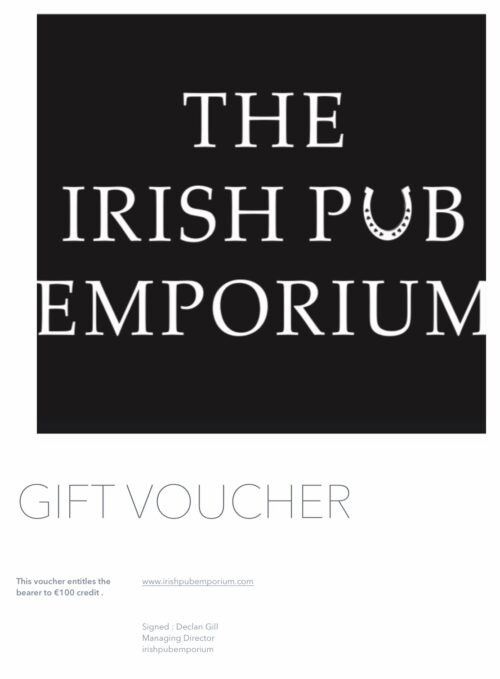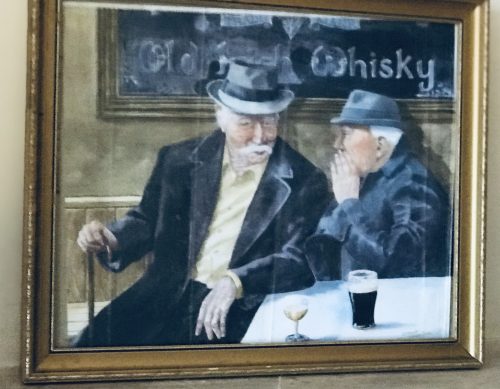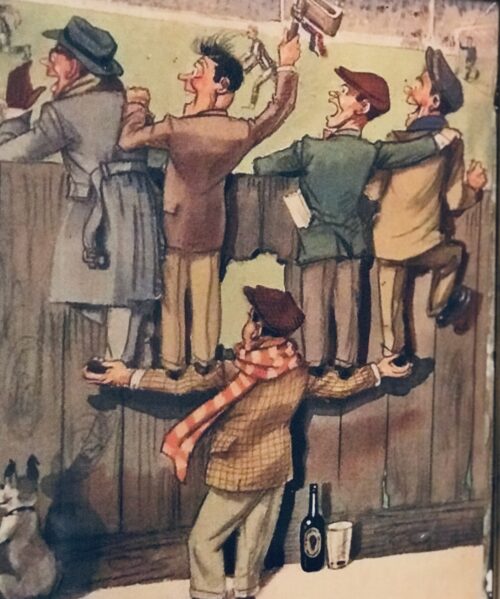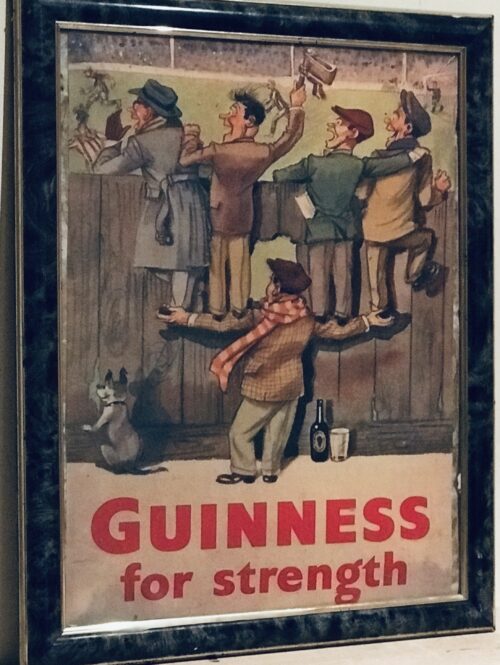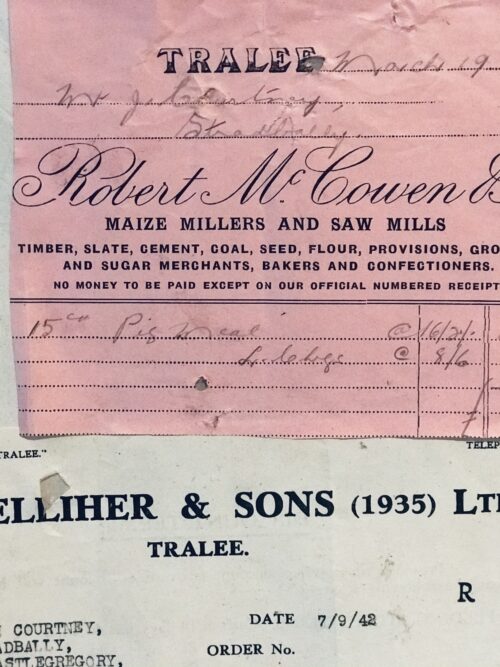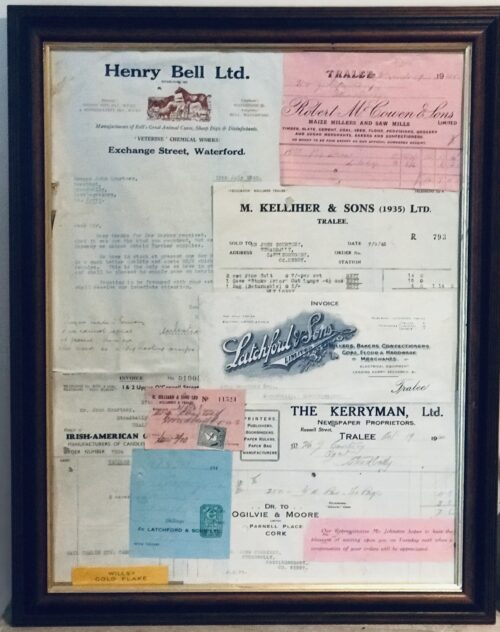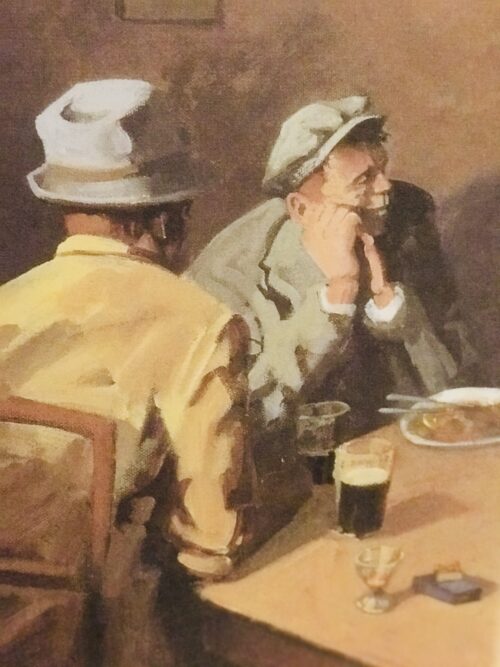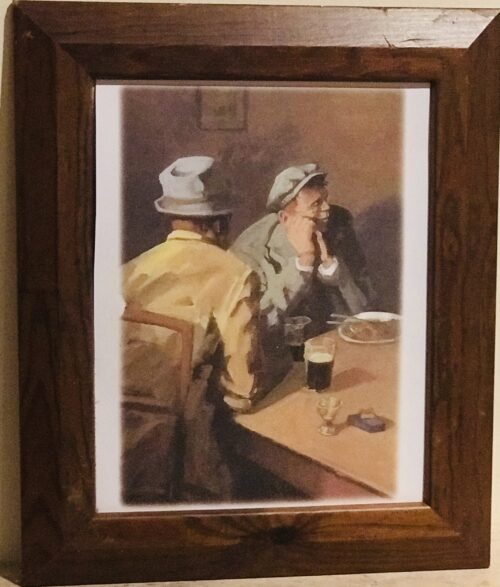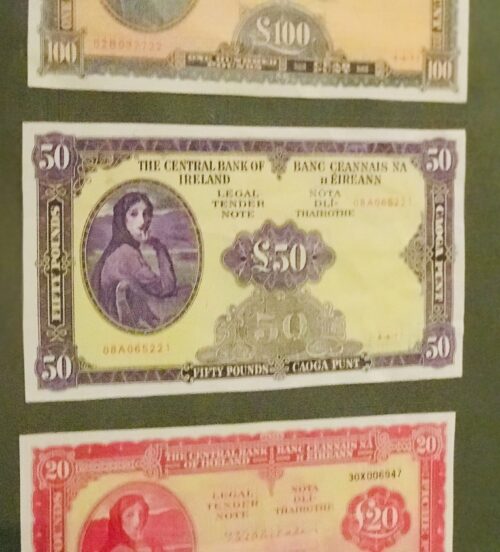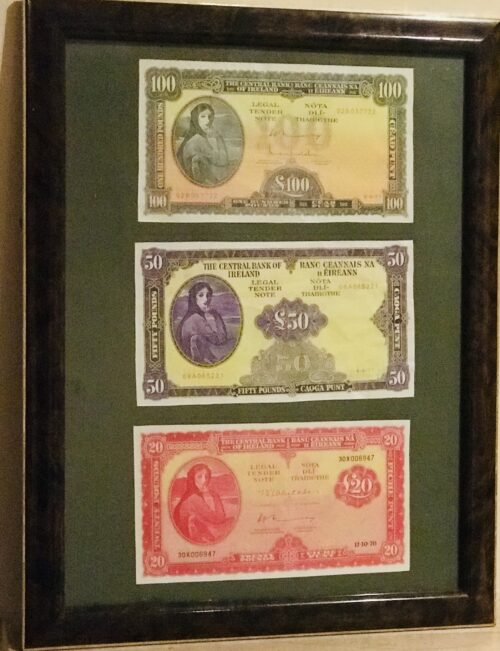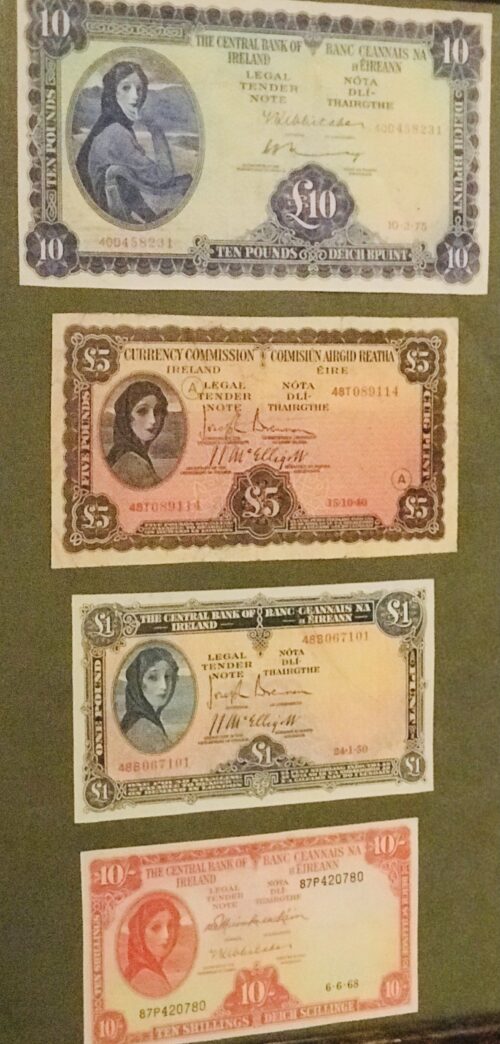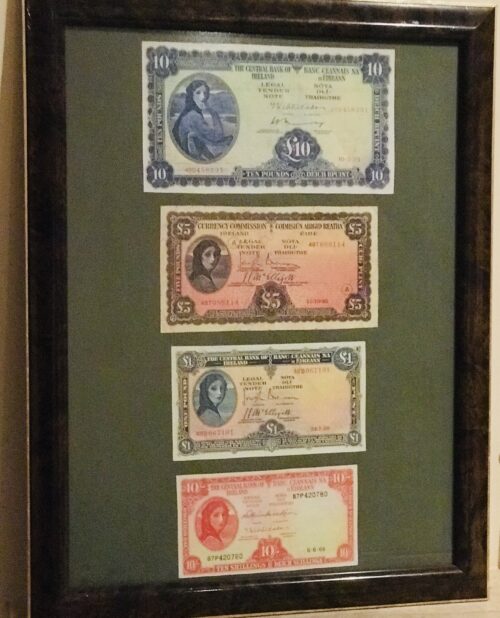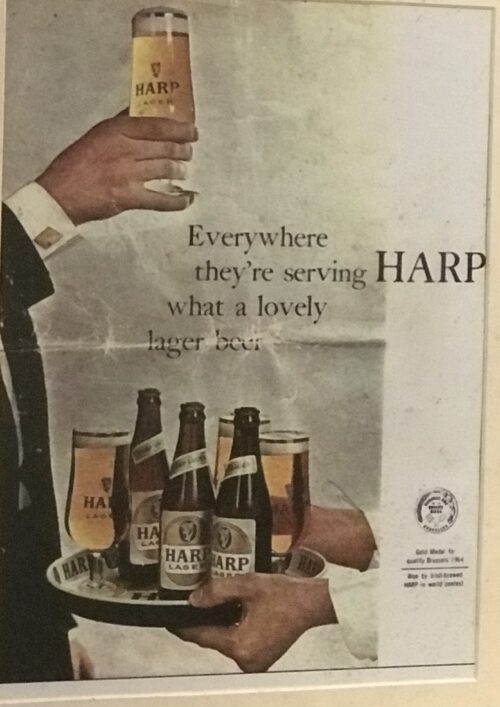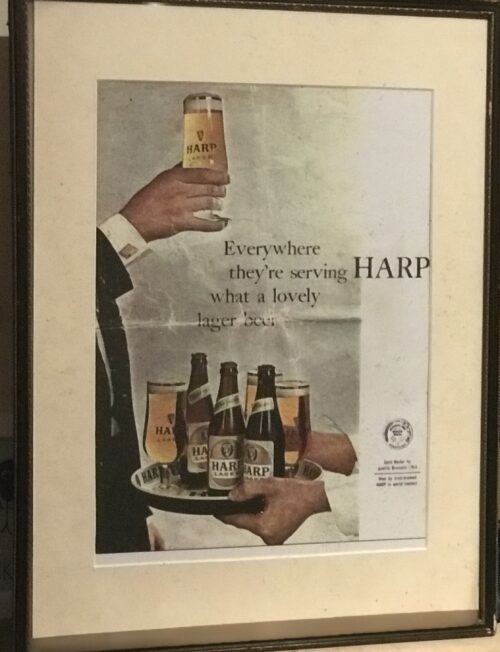Great piece of old Irish Musical Nostalgia- an old poster advertising Joe Dolan playing at the Central theatre in Tullamore Co Offaly on Sunday 19th March,some time in the late 1970s.
Joseph Francis Robert "Joe" Dolan (16 October 1939 – 26 December 2007), otherwise known as Boots, was an Irish entertainer, recording artist, and pop singer. Chiefly known in Ireland for his association with
showbands and for his innovative style and high pitched singing voice, he had a wide appeal with many international fans. His energetic and charismatic stage performances were well known as was his long standing advertising slogan: "There's no show like a Joe show".
The only Irish singer to reach number one in the 1960s, 1970s, 1980s, and 1990s, Dolan was a constant presence on the hit parade in Ireland and overseas.
Dolan was born at the County Hospital, now known as the
Midland Regional Hospital, Mullingar,
County Westmeath on 16 October 1939,
the youngest of eight children in a
Roman Catholicfamily. He was orphaned at a young age – his father, a bicycle shop proprietor, died when Joe was eight; his mother when he was fifteen. He sang in school, and his mother had encouraged him to take up the piano. He made his first stage appearance at a talent show held in a marquee on the Fair Green in his native
Mullingar.
Dolan's voice was high with a comprehensive range without the use of
falsetto and he made comprehensive use of a technique known as
melisma which gives the vocal a plaintive edge reminiscent of
Arabic religious chanting. Vocal gymnastics such as this were not common in the 1960s and 1970s but were later made popular by artists such as
Mariah Carey,
Stevie Wonder and
Whitney Houston, among others.
As well as securing his first (and last) "real" job as a compositor in local newspaper The
Westmeath Examiner in 1958, he got his first guitar. After learning some skills on the instrument, he and his saxophone-playing brother Ben started to play in local bands. They soon formed a band of their own – The Drifters. Not long afterward, the band was renamed Joe Dolan and the Drifters and finally Joe Dolan and
His Drifters to avoid legal action from the
American band of the same name.
The Irish musical landscape in the 1960s was dominated by the
showbands. The first single "The Answer to Everything", (previously released as a B side by
Del Shannon) was released in September 1964, quickly reaching number 4 in the Irish charts. Dolan and his band were managed by Seamus Casey. In the summer of 1968, however, some of the band left, with Dolan and Casey citing "musical differences" as the reason, although in the official biography by Ronan Casey (Seamus Casey's son) further elaboration includes references to unhappiness about financial issues.
Dolan never achieved any notable chart success in the U.S. but had good acclaim with concert audiences in carefully targeted areas. His first tour in 1965 followed an offer, which he refused, to play in Las Vegas. Instead, he decided to play a whistle-stop tour of Irish-American venues in places such as Chicago, New York and
Boston. An added benefit to this string of engagements was the opportunity to hear American music which hadn't yet been played in the UK and Ireland. The first song gleaned in this fashion was the
Jim Reeves classic,
(That's When I see the Blue in Your) Pretty Brown Eyeswhich Dolan released on the Pye label in 1966.
A second US tour in 1967 led to an appraisal in Las Vegas and a substantial offer to appear there but he turned it down.
Eventually in 1980 he accepted $10,000 a week plus board and lodgings to perform for six weeks over September and October at the Continental Lounge of the
Silverbird Casino on the Strip in Las Vegas.
Eventually playing 64 shows and selling out most of them, he and his band returned to Ireland to be immediately rebooked for Vegas in January 1981.
Although this trip was a further success, he turned down subsequent offers to return to Vegas. When word of this got out, other venues approached him with increased offers, thinking he was merely hunting around for the best deal, but the singer refused them all. Several other attempts were made through the years to entice him back but he never returned – except on holiday.
In 1978, he became the first Irish artist and one of the first Western acts to tour communist Russia.
Joe toured the segregation era in South Africa and was on a UN blacklist for defying the artists' ban.
After reforming the band Dolan recorded a song called "Make Me an Island", written by the songwriting duo Albert Hammond and Mike Hazlewood,
for
Pye Records in conjunction with Shaftesbury Publishing. The track was a hit in England and led to Dolan's first appearance on the BBC's
Top of the Pops and helped to make him the biggest Irish star in the world at that time,
eventually becoming a number one hit in 14 countries, as well as reaching Number 3 in the UK, becoming Joe Dolan's only British Top 10 hit, and one of only four hit singles Dolan ever had in the UK (all of these hits performed better in the Irish Charts).
In Ireland, the song peaked at number 2 in August 1969, the same week it was Number 3 in the UK. It has been claimed that Dolan was the first Irish star to appear on
Top of the Pops,
[18] although this supposes that neither
The Bachelors nor
Val Doonican appeared on the show between 1964 and 1969 (which seems at least doubtful given that both had several big hits in both the UK and Ireland in the mid-'sixties). After the recording of
Make Me An Island, Dolan was approached and signed by
the MAM Agency whose major star was
Tom Jones.
Follow-up singles "Teresa" and "You're Such a Good Looking Woman" also made an impact. Other single releases such as "It Makes No Difference" and "You and the Looking Glass" were not big hits at home in Ireland or in the UK, but they were international successes. A collaboration with writers
Roberto Danova and Peter Yellowstone in the mid-1970s produced more singles which made little impact on the British domestic market but did well internationally. "Sweet Little Rock 'n’ Roller" (1974) was the first of a number of reasonable successes for this team but wasn't a major hit in the UK until later recorded by
Showaddywaddy, who had a Top 20 hit with the song in 1979.
His next single, "Lady in Blue" was his biggest ever hit, winning five gold records and selling one million copies.
It was popular in Europe,
Australasia, Africa and South America but not in Ireland or the UK. Further hits including "Crazy Woman", "Sister Mary", "Midnight Lover", "Hush Hush Maria" and "I Need You" followed. Reflective songs such as "If I Could Put My Life on Paper" were a collaborative attempt to show a more maturing artist, whilst definitive versions of songs such as "Danny Boy" maintained a touch of Irish on disc and in concert. In any given month Dolan could be touring the Middle East one week, Australia the next, then South Africa and then back to Europe and Ireland. Further international successes and tours followed, with hits such as "More and More" and "It's You, It's You, It's You".
With his own record label, studio and material Dolan became one of the biggest selling independent artists of the 1990s with albums such as 'Endless Magic' keeping him near the top of the charts. At the end of the decade he refined his voice for the 21st century when he hooked up with
EMI for a series of albums (such as
Joe's 90s,
21st Century Joe and
Home Grown) which saw him tackle more contemporary music from acts as diverse as
Oasis,
Pulp,
Blur,
U2,
Bruce Springsteen,
The Coral,
R.E.M.,
Mundy and his old pal
Robbie Williams. At the
Oxegen Festival 2009, Blur's
Damon Albarn dedicated the song "The Universal" to Dolan.
Dolan never married and dealt with speculation about his sexuality throughout his life. He dismissed persistent rumours that he was gay. The official biography suggests that he had a quiet offstage presence and preferred to keep romances out of the public eye but cites a long relationship with Isabella Fogarty whom he met in 1977, started dating in the 1980s and subsequently lived with.
She was with him when he became ill on 25 December 2007.
In September 1970, Dolan and his band were performing at the Wookie Hollow Club in
Liverpool. Dolan and a member of his road crew stayed in the venue for drinks and to chat to their fans. Some people at a nearby table were attempting to bully the (by now closed) bar into providing them with champagne. Dolan joked that they should come back in a few hours for a "champagne breakfast". The men took exception to this and became abusive. Dolan and his companion tried to leave but were prevented from doing so. During the following fracas Dolan was headbutted, (breaking his nose) kicked, punched and slammed into lavatory fittings and a wall in a sustained attack which was only halted when the sound of police sirens could be heard.
It took six weeks for the singer to recover well enough to return to work. The club was sued but went into liquidation. The police attempted to identify the perpetrators and held identity parades which Dolan attended but no-one was ever prosecuted.
In October 1976, Dolan and a group of friends were flying with
Aer Lingus to
Corfu for a golfing trip.
On several occasions during the flight Dolan was moving around talking to other passengers who knew him. One of the party remembers they were "quite merry".
The singer was asked several times by cabin staff to return to his seat and, finally, after being threatened with being "restrained" he did so. Upon landing, he attempted to leave the airport without his luggage and passport but was prevented from doing so by security staff, one of whom drew his pistol and pointed it at Dolan.
The tour operator subsequently received a fax from Aer Lingus refusing to fly the star back to Dublin. Newspaper headlines in Ireland proclaimed the star's airline ban for life although, as it transpired, the ban only lasted for close to two years, eventually being lifted after the airline negotiated with the star following his continued references to it on stage and in the media.
Dolan's health began to decline after he underwent a
hip replacement in 2005, which put him off the road for 12 months and led to the discovery of
Type 2 Diabetes which appeared to account for the low energy levels he had been experiencing.
In a bizarre twist, following a discussion with
Keith Duffy of the boyband
Boyzone, the hip bone which was replaced was signed and auctioned for €650, the proceeds being given to Irish Autism Action. Dolan returned to his schedule in 2006, initially with vigour, but soon began to report further signs of low energy.
Doctors diagnosed a low blood platelet count and Dolan began a series of blood transfusions, After each, he felt better for a period, but always began to feel weaker again. At this same time, Dolan was also suffering from unexplained nosebleeds.
In autumn 2007, on advice from his doctors, Dolan cancelled his
Vicar Street concerts due to "exhaustion".
On 16 December 2007, the front page of the
Sunday Independent reported that Dolan was suffering from a "bad virus" and had been forced to cancel his entire Christmas tour.
Dolan's website was inundated with well wishes in the wake of the article, which was reproduced in several newspapers the following day. Despite the blood transfusions and other medical interventions, Dolan became weaker and he was finally discharged from the
Mater Private Hospital in Dublin on 23 December 2007 in a wheelchair.
Dolan spent
Christmas Day 2007 at his home in
Foxrock in southeast Dublin with some friends. Later that evening, his illness suddenly worsened, and he was rushed by ambulance to the Mater Hospital. En route to the hospital, Dolan suffered a massive
intracerebral haemorrhage, at which he became unconscious, and was connected to life support equipment upon his arrival. At approximately 14:30 hours on
St Stephen's Day, surrounded by family and friends, the machines were switched off
and Dolan died within 20 minutes, never regaining consciousness. He was pronounced dead at 15:03 hours.
He was 68 years old.
His funeral mass was held at the
Cathedral of Christ the King, Mullingar, on 29 December 2007. Many famous faces from both sides of the border attended, including singer
Ronnie Drew from
The Dubliners, comedian
Frank Carson, snooker legend
Denis Taylor and former
Taoiseach Albert Reynolds.

Grave of Joe Dolan at Walshestown Cemetery, Mullingar
Dolan is interred in Walshestown Cemetery,
Walshestown North, County Westmeath.
A 540 metres (1,770 ft) bridge was named after him in the Clonmore Industrial Estate in his hometown of Mullingar, it opened officially on 6 September 2010;
it is the longest bridge in the Republic Of Ireland.
There is a statue of Dolan in Mullingar's Market Square.
Dolan's hip bone is the only body part to ever be sold on eBay.
The singer had initially sold his bone at a charity auction before his death and it was later sold on eBay.
Origins : Co Offaly
Dimensions : 54cm x 40cm 6kg
 J Matterson & Sons operated out of Roches Street, while their rival company O’Mara’s operated across the road on the same street from 1839. Mattersons was established in 1816 by John Russell and J Matterson, who were brother-in-laws of a kind. Both men married a Mossop sister, Mary and Eleanor.
After the death of Joseph Matterson Snr in 1854, Joseph Matterson Jnr took over the Limerick aspect of the company. While Joseph Matterson Snr’s other son William Matterson, oversaw the London branch of the business. William Matterson died aged 71 in London in January 1903.
Not only was Joseph Matterson Jnr. a business owner in the city but he was also a key player in the community. He was vice president of the Protestant Young Mens Association which stained-glass window still remains in-situ in O’Connell Street.
Below are the funeral notices from the Limerick Chronicle, from the Limerick City Library Local Studies, for members of the Matterson Family.
J Matterson & Sons operated out of Roches Street, while their rival company O’Mara’s operated across the road on the same street from 1839. Mattersons was established in 1816 by John Russell and J Matterson, who were brother-in-laws of a kind. Both men married a Mossop sister, Mary and Eleanor.
After the death of Joseph Matterson Snr in 1854, Joseph Matterson Jnr took over the Limerick aspect of the company. While Joseph Matterson Snr’s other son William Matterson, oversaw the London branch of the business. William Matterson died aged 71 in London in January 1903.
Not only was Joseph Matterson Jnr. a business owner in the city but he was also a key player in the community. He was vice president of the Protestant Young Mens Association which stained-glass window still remains in-situ in O’Connell Street.
Below are the funeral notices from the Limerick Chronicle, from the Limerick City Library Local Studies, for members of the Matterson Family.
 In 1901 Joseph Matterson, Jnr aged 60 was living with his 46 year old wife Agnes and children Leopold (18), Vera Sunderland(9), Victor (7), Eva (5) and a seven various servants. Joseph Matterson Jnr and his wife Agnes had 12 children in total with 9 still living in 1911, married 33 years. After Joseph’s death in 1906, Agnes and family moved to the Ennis Road, her children Ian Gordon and Vera Sunderland were living with her in 1911.
The following also courtesy of Pat Mossop is a wonderful letter written by a Limerick lady in 1873: Eleanor McGhie, an article by Sharon Slater based on the letter was published in the Old Limerick Journal.
In 1901 Joseph Matterson, Jnr aged 60 was living with his 46 year old wife Agnes and children Leopold (18), Vera Sunderland(9), Victor (7), Eva (5) and a seven various servants. Joseph Matterson Jnr and his wife Agnes had 12 children in total with 9 still living in 1911, married 33 years. After Joseph’s death in 1906, Agnes and family moved to the Ennis Road, her children Ian Gordon and Vera Sunderland were living with her in 1911.
The following also courtesy of Pat Mossop is a wonderful letter written by a Limerick lady in 1873: Eleanor McGhie, an article by Sharon Slater based on the letter was published in the Old Limerick Journal.
 Shaw & Sons operated out of Mulgrave Street. It was founded in 1831 by William John Shaw, whose family originated in Co. Down. In 1892 Shaw’s factory was using electric lights, lifts, a mini-railway and even telephonic communications, the Shaw’s factory was well ahead of it’s time. It is now owned by the Kerry Group.
Below are the funeral notices from the Limerick Chronicle, from the Limerick City Library Local Studies, for members of the Shaw Family.
Shaw & Sons operated out of Mulgrave Street. It was founded in 1831 by William John Shaw, whose family originated in Co. Down. In 1892 Shaw’s factory was using electric lights, lifts, a mini-railway and even telephonic communications, the Shaw’s factory was well ahead of it’s time. It is now owned by the Kerry Group.
Below are the funeral notices from the Limerick Chronicle, from the Limerick City Library Local Studies, for members of the Shaw Family.
 Alexander William Shaw – 27 October 1847 – 29 November 1923Derravoher North Circular Road,bacon curer and local politician and the founder of Limerick and Lahinch golf clubs. He was born in County Limerick, the second son of John Shaw (son of WJ Shaw) of Willowbank, bacon merchant. The family firm was already thriving when he took it over, but under his astute management it grew to become one of the largest bacon curing businesses in Europe, and Shaw became one of the most prominent businessmen in the city.
Alexander William Shaw – 27 October 1847 – 29 November 1923Derravoher North Circular Road,bacon curer and local politician and the founder of Limerick and Lahinch golf clubs. He was born in County Limerick, the second son of John Shaw (son of WJ Shaw) of Willowbank, bacon merchant. The family firm was already thriving when he took it over, but under his astute management it grew to become one of the largest bacon curing businesses in Europe, and Shaw became one of the most prominent businessmen in the city.
 Denny’s and Sons operated out of 27 Upper William Street in in 1891 as well as Mulgrave Street. It was founded by Henry Denny in the 1870s and first operated as a Provision Merchants out of Newtown Mahon, Upper William Street. Denny operated out of Limerick, Cork and Waterford. Denny’s sausages make an appearance in James Joyce’s Ulysses, where Leopold Bloom watches a young girl in Dlugacz’s butcher’s shop buy a pound and a half of Denny’s sausages, as he waits to buy a pork kidney for his and wife Molly’s breakfast. Denny’s is now owned by the Kerry Food group, after they acquired it in 1982.
Dimensions :230cm x 10cm x 8cm
Denny’s and Sons operated out of 27 Upper William Street in in 1891 as well as Mulgrave Street. It was founded by Henry Denny in the 1870s and first operated as a Provision Merchants out of Newtown Mahon, Upper William Street. Denny operated out of Limerick, Cork and Waterford. Denny’s sausages make an appearance in James Joyce’s Ulysses, where Leopold Bloom watches a young girl in Dlugacz’s butcher’s shop buy a pound and a half of Denny’s sausages, as he waits to buy a pork kidney for his and wife Molly’s breakfast. Denny’s is now owned by the Kerry Food group, after they acquired it in 1982.
Dimensions :230cm x 10cm x 8cm


